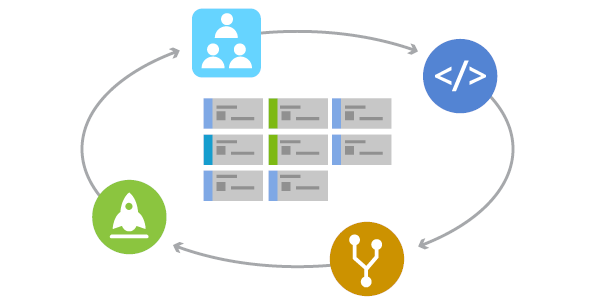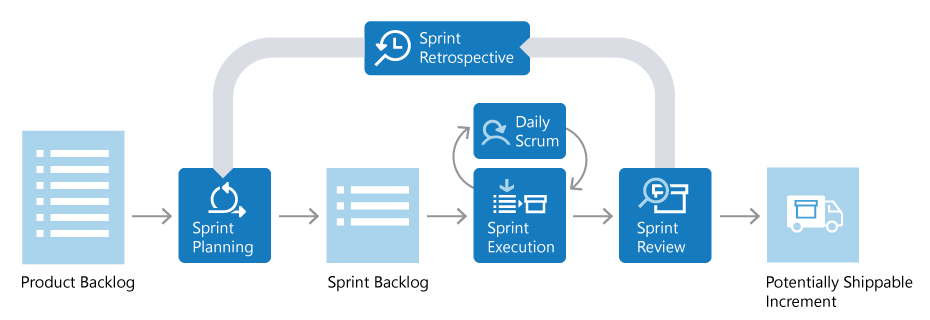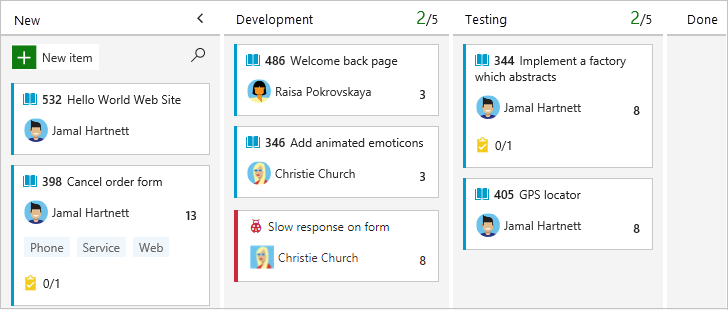Kanban, Scrum, and Agile are all project management approaches that emphasize efficiency, collaboration, and iterative development.

What's Agile?
Agile is an iterative and incremental approach to project management that promotes flexibility, collaboration, and continuous improvement.
- It is a broad and flexible approach to project management that emphasizes iterative development, collaboration, and responding to change.
- It values individuals and interactions, working software, customer collaboration, and responding to change over following rigid plans and processes.
- Agile encourages adaptive planning, self-organizing teams, and frequent iterations to deliver incremental value.
- Various frameworks and methodologies, such as Scrum and Kanban, fall under the Agile umbrella, each with its own specific practices and principles.

Image Ref: What's Agile
What are the key features of Agile?
Agile, as an approach to project management, encompasses several key features that distinguish it from traditional methods. These features include:
1) Iterative and Incremental Development
- Agile projects are broken down into shorter iterations or cycles, allowing for continuous development and regular delivery of working increments, allowing for regular inspection, adaptation, and feedback.
- Each sprint typically lasts 1-4 weeks and results in a potentially shippable product increment.
- This iterative approach allows for regular inspection and adaptation, enabling teams to respond to changes and incorporate feedback more effectively.
2) Adaptive and Continuous Planning
- Agile embraces adaptive planning rather than rigid, upfront planning.
- Instead of trying to predict and plan for every detail upfront, Agile teams focus on creating a high-level roadmap and prioritize work based on customer value.
- Detailed planning is done incrementally and continuously throughout the project, allowing for adjustments as new information and feedback emerge.
3) Customer Collaboration
- Agile emphasizes active involvement and collaboration with customers or stakeholders throughout the project.
- By involving customers throughout the project and incorporating their feedback, Agile helps ensure that their expectations are met, enhancing customer satisfaction.
4) Self-Organizing Teams
- Agile promotes self-organizing teams that have the autonomy to make decisions, assign work, and adapt to changing circumstances.
5) Cross-Functional Teams
- Agile promotes self-organizing, cross-functional teams that have all the necessary skills and expertise to complete the work within each sprint. Team members collaborate closely, communicate openly, and collectively take ownership of the project's success.
6) Continuous Planning
- Agile plans are flexible and continuously adapted based on feedback, allowing for adjustments and prioritization of work as the project progresses.
7) Embracing Change
- Agile welcomes change and is designed to accommodate evolving requirements, allowing for flexibility and adaptation.
- Agile recognizes that change is inevitable and embraces it as a competitive advantage.
- Agile teams are responsive to changing requirements, market conditions, and customer feedback.
- Instead of resisting change, Agile approaches it as an opportunity to deliver better outcomes.
8) Continuous Improvement
- Agile fosters a culture of ongoing learning and improvement through regular reflection, feedback, and adjustments to enhance project outcomes.
- Teams regularly reflect on their work and processes through retrospectives, identifying areas for enhancement and implementing changes in subsequent iterations.
- This promotes learning, experimentation, and a commitment to delivering higher value with each iteration.
9) Face-to-Face Communication
- Agile emphasizes direct and frequent communication among team members and stakeholders to ensure effective collaboration and problem-solving.
10) Feedback-Driven Development
- Agile relies on continuous feedback from customers and stakeholders to validate assumptions, refine the product, and improve its alignment with user needs.
11) Agile Frameworks and Methodologies
- Agile is a broad philosophy that encompasses several frameworks and methodologies. Some popular Agile frameworks include Scrum, Kanban, Extreme Programming (XP), and Lean.
- These frameworks provide specific guidelines, roles, ceremonies, and practices to implement Agile principles effectively
How does Agile benefit me?
In terms of how Agile can benefit you, it offers the following advantages:
- Flexibility and Adaptability: Agile enables you to respond and adapt to changing circumstances, requirements, and customer feedback more effectively.
- Customer Satisfaction: By involving customers throughout the project and incorporating their feedback, Agile helps ensure that their expectations are met, enhancing customer satisfaction.
- Faster Time to Market: Agile's iterative approach allows for early and regular delivery of working increments, reducing time to market and enabling rapid value realization.
- Transparency and Visibility: Agile promotes transparency and visibility across the project. Through practices like daily stand-up meetings, sprint reviews, and visual boards, Agile enables all team members to have a clear understanding of the project's progress, goals, and priorities. This transparency enhances collaboration and coordination within the team.
- Collaboration and Empowerment: Agile promotes collaboration, teamwork, and shared responsibility, empowering team members to contribute their expertise and improve overall project outcomes.
- Continuous Improvement: Agile fosters a mindset of continuous learning and improvement, enabling teams to refine their processes, optimize productivity, and deliver higher-quality results over time.
- Risk Mitigation: Agile's iterative nature enables early identification and mitigation of risks through regular inspection, adaptation, and feedback loops.
- Stakeholder Engagement: Agile encourages the active involvement of stakeholders, fostering trust, alignment, and shared ownership of project outcomes.
Which Tools Should I Use with Agile?
There are several tools that can be used to support Agile project management. The choice of tools depends on your specific needs, team preferences, and the Agile framework you are using.
Here are some commonly used tools in Agile project management:
1. Agile Project Management Software:
- Jira Software: Jira is a popular tool that supports Agile methodologies such as Scrum and Kanban. It provides features for backlog management, sprint planning, task tracking, and collaboration. Jira offers extensive customization and integration options, making it suitable for complex Agile projects.
- Azure DevOps: Formerly known as Visual Studio Team Services (VSTS), Azure DevOps is a comprehensive platform that includes features for Agile project management, version control, continuous integration, and delivery. It integrates well with other Microsoft tools and services.
- Rally (CA Agile Central): Rally is an Agile project management platform designed to support large-scale Agile transformations. It offers features for backlog management, release planning, team collaboration, and reporting.
- VersionOne: VersionOne is an Agile project management tool that supports various Agile methodologies. It provides features for backlog management, sprint planning, resource allocation, and reporting. VersionOne also offers integrations with other development and testing tools.
2. Task Management and Collaboration Tools:
- Trello: Trello is a flexible and visual task management tool based on the Kanban methodology. It allows teams to create boards, lists, and cards to track and manage work. Trello is suitable for smaller Agile teams or projects with a simpler workflow.
- Asana: Asana is a versatile project management and collaboration tool that supports Agile practices. It provides features for task management, project planning, team communication, and reporting. Asana offers a range of integrations to connect with other tools.
- Monday.com: Monday.com is a team collaboration and project management platform that can be customized to fit Agile workflows. It offers features for task tracking, team collaboration, and progress visualization.
You might also like to read Jira vs Asana vs Trello: Which Tool should I Use?
3. Communication and Collaboration Tools:
- Microsoft Teams: Microsoft Teams is a collaboration platform that integrates with other Microsoft tools and services. It provides features for chat, video meetings, document collaboration, and project management integration.
- Slack: Slack is a popular team communication tool that facilitates real-time collaboration, discussions, and file sharing. It supports Agile teams by enabling quick communication, sharing updates, and fostering teamwork.
Remember that the tool you choose should align with your team's needs and preferences, support Agile principles, and facilitate efficient communication, collaboration, and task management. It's recommended to involve your team in the decision-making process and consider conducting trials or demos to assess the tools' suitability for your Agile projects.
What's Scrum?
Scrum is an Agile framework for managing and organizing complex projects.
- Scrum is an iterative and incremental framework within the broader Agile methodology.
- It provides a lightweight and iterative approach that enables teams to collaborate, adapt to change, and deliver value-driven results.
- It operates in time-boxed iterations called sprints, typically lasting 1-4 weeks.
- Scrum teams have predefined roles (Product Owner, Scrum Master, and Development Team) and follow specific ceremonies (Sprint Planning, Daily Stand-ups, Sprint Review, and Sprint Retrospective).
- Scrum promotes collaboration, self-organization, and regular inspection and adaptation of the product and process.
- The focus is on delivering a potentially shippable product increment at the end of each sprint, with customer feedback shaping future iterations.

Image Ref: Scrum Life Cycele
What're the Roles in Scrum?
Product Owner:
- The Product Owner represents the stakeholders and acts as the primary liaison between the team and stakeholders. They are responsible for defining and prioritizing the product backlog, ensuring the team delivers value to the customers.
Scrum Master:
- The Scrum Master is responsible for facilitating the Scrum process, removing any obstacles that hinder the team's progress, and ensuring adherence to Scrum principles and practices.
Development Team:
- The Development Team is a self-organizing group of professionals who collaborate to deliver the product increment. They are responsible for analyzing, designing, developing, testing, and delivering high-quality increments.
What're the Scrum Artifacts?
Product Backlog:
- The Product Backlog is a prioritized list of user stories, features, or items that define the product requirements. It is managed by the Product Owner and serves as a dynamic document that evolves throughout the project.
Sprint Backlog:
- The Sprint Backlog contains the tasks identified by the Development Team to be completed during a specific sprint. It is derived from the Product Backlog and represents the work the team commits to delivering within the sprint.
Increment:
- The Increment is the sum of all completed and tested Product Backlog items at the end of a sprint. It is a potentially shippable product that provides value to the customer.
What're the Scrum Events Types?
- Sprint: A Sprint is a time-boxed iteration in which the Development Team works to deliver a potentially shippable product increment. Sprints usually last 1-4 weeks, and each Sprint begins with a Sprint Planning meeting and concludes with a Sprint Review and Retrospective.
- Sprint Planning: In the Sprint Planning meeting, the Product Owner and the Development Team collaborate to determine which items from the Product Backlog will be worked on in the upcoming Sprint. The team breaks down the selected items into tasks and estimates the effort required.
- Daily Scrum: The Daily Scrum is a brief, time-boxed meeting where the Development Team synchronizes its work. Each team member shares progress, plans for the day, and any impediments they are facing. The Scrum Master facilitates the meeting.
- Sprint Review: The Sprint Review is held at the end of the Sprint, where the Development Team presents the completed Increment to stakeholders, gathering feedback and insights. Adjustments to the Product Backlog may be made based on this feedback.
- Sprint Retrospective: The Sprint Retrospective is a reflection meeting held after the Sprint Review. The team reflects on the Sprint, identifies what went well, and areas for improvement, and develops action items to enhance their processes.
When should I use Scrum?
As we earlier mentioned, Scrum is widely used in software development but can be applied to various industries and projects. It provides a framework that fosters collaboration, flexibility, and continuous improvement, enabling teams to deliver high-quality products that meet customer needs.
Here are some situations where Scrum is commonly used:
- Scrum is effective for projects that involve complex requirements, technologies, or domains where the end goals may not be fully defined upfront. Its iterative and adaptive nature allows teams to gather feedback, learn, and adjust their approach as they progress.
- Scrum is a popular choice for Agile software development projects. If you are looking to embrace Agile principles such as collaboration, flexibility, and customer focus, Scrum provides a framework that aligns with these values.
- Scrum is beneficial when you have cross-functional teams that encompass all the necessary skills and expertise to complete the project. This includes roles such as developers, testers, designers, and business analysts. The collaboration and self-organization encouraged by Scrum enable these diverse skills to come together effectively.
- If your project involves evolving requirements or has a high likelihood of change, Scrum's flexibility allows you to adapt and incorporate changes throughout the project. Scrum's frequent inspection and adaptation cycles facilitate a responsive approach to changing needs.
- Scrum's time-boxed iterations, known as sprints, provide a structured framework for delivering increments of value within fixed timeframes. This can be advantageous for time-critical projects where regular releases and fast feedback loops are essential.
- If you prioritize involving customers or stakeholders in the development process and seek their regular feedback and input, Scrum's customer-centric approach is well-suited. It provides mechanisms for collaboration and ensures that customer needs and expectations are continuously addressed.
- If you prioritize involving customers or stakeholders in the development process and seek their regular feedback and input, Scrum's customer-centric approach is well-suited. It provides mechanisms for collaboration and ensures that customer needs and expectations are continuously addressed.
- If you value a culture of continuous learning, improvement, and reflection, Scrum's regular retrospectives promote this mindset. Teams can regularly assess their performance, identify areas for enhancement, and implement changes to optimize their processes and outcomes.
While Scrum is widely used, it's important to assess the specific needs and characteristics of your project and team before deciding to adopt it. Different project management methodologies may be more appropriate in certain contexts, so consider factors like team size, organizational culture, and project complexity when determining if Scrum is the right fit for your situation.
What's Kanban?
Kanban is an Agile project management methodology that focuses on visualizing work, limiting work in progress (WIP), and optimizing flow. It originated from the Toyota Production System and has been adapted for various industries and projects.
- Kanban is a visual project management system that focuses on continuous flow and limiting work in progress (WIP).
- It utilizes a Kanban board where work items are represented as cards and moves across columns that represent different stages of the workflow.
- Kanban emphasizes transparency, enabling teams to visualize their work, identify bottlenecks, and optimize their process.
- The primary goal of Kanban is to optimize the flow of work, maintain a balanced workload, and deliver value in a steady and predictable manner.

Image Ref: Kanban boards
When Should I Use Kanban?
- If you need a visual representation of your workflow to track progress and task status easily,
- If you have variable workloads or frequently changing priorities that require quick adaptation,
- If you want to identify and address bottlenecks in your processes for improved efficiency,
- If you value collaboration and transparency among team members,
- If you prioritize continuous improvement and want to foster a culture of learning,
- If you aim to increase productivity by providing clarity and focus on tasks,
- If you need a flexible approach to accommodate planned and unplanned work,
- If you want to prevent work overload and maintain a balanced workload for team members,
- If you seek a method that promotes accountability and ownership of tasks.
Conclusion
In summary, Kanban is a visual workflow management system focused on continuous flow, Scrum is an iterative framework within Agile that uses sprints and defined roles, and Agile is a broader mindset and approach that emphasizes adaptability and customer collaboration.
The choice between Kanban, Scrum, or Agile depends on the specific needs of your project, team dynamics, and the level of structure and flexibility required.
See Also